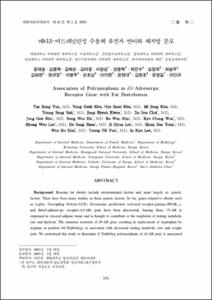KUMEL Repository
1. Journal Papers (연구논문)
1. School of Medicine (의과대학)
Dept. of Internal Medicine (내과학)
베타3-아드레날린성 수용체 유전자 변이와 체지방 분포
- Keimyung Author(s)
- Kim, Hye Soon; Lee, In Kyu; Suh, Young Sung; Kwon, Jung Hyeok; Choi, Jin Soo
- Journal Title
- 대한내분비학회지
- Issued Date
- 2003
- Volume
- 18
- Issue
- 2
- Abstract
- Background: Reasons for obesity include environmental factors and, more largely so, genetic factors. There have been many studies on these genetic factors. So far, genes related to obesity such as Leptin, Uncoupling Protein (UCP), Peroxisome proliferator activated receptor-gamma(PPAR-γ), and Beta3-adrener-gic receptor(ß3-AR) gene have been discovered. Among these, ß3-AR is expressed in visceral adipose tissue and is thought to contribute to the regulation of resting metabolic rate and lipolysis. The missense mutation of ß3-AR gene, resulting in replacement of tryptophan by arginine at position 64(Trp64Arg), is associated with decreased resting metabolic rate and weight gain. WE performed this study to determine if Trp64Arg polymorphism of ß3-AR gene is associated with obesity in Koreans. Method: We investigated the relationship between the ß3-AR gene mutation and body mass index (BMI), waist circumference, hip circumference, waist to hip ratio (VSR), and lipid profile. 198 subjects were included in this study of which 97 were of normal weight and 101 were obese. Anthropometric data was obtained from physical examination and medical records. Result: In the cases of ß3-AR gene mutation of the obese group, the ratio of Trp/Arg and Arg/Arg are 43% and 5%, respectively, which were higher than the normal group (36%, 1%), although a statistical significant was not found. There was significant difference in the are of subcutaneous fat. Normal group (Trp/Trp) measured at 213.9±109.6cm² versus 244.0±127.7cm² (Trp/Arg) and 323.9±189.9cm²(Arg/Arg) for the mutation groups. Circumference of waist, circumference of hip, WHR, area of visceral fat, and VSR were higher in the mutation groups than in normal subject, but not significantly different. Conclusion: These results suggest that a genetic mutation in the ß3-AR gene can affect body fat composition, and is associated with obesity in Korean adults (J Kor Soc endocrinol 18:184~192,2003). Key Words: Obesity, Beta3-adrenergic receptor, Subcutaneous fat
- Alternative Title
- Association of Polymorphism in ß3-Adrenergic Receptor Gene with Fat Distribution
- Publisher
- School of Medicine
- Citation
- 윤태승 et al. (2003). 베타3-아드레날린성 수용체 유전자 변이와 체지방 분포. 대한내분비학회지, 18(2), 184–192.
- Type
- Article
- ISSN
- 2093-596X
- 파일 목록
-
-
Download
 oak-bbb-05374.pdf
기타 데이터 / 399.94 kB / Adobe PDF
oak-bbb-05374.pdf
기타 데이터 / 399.94 kB / Adobe PDF
-
Items in Repository are protected by copyright, with all rights reserved, unless otherwise indicated.